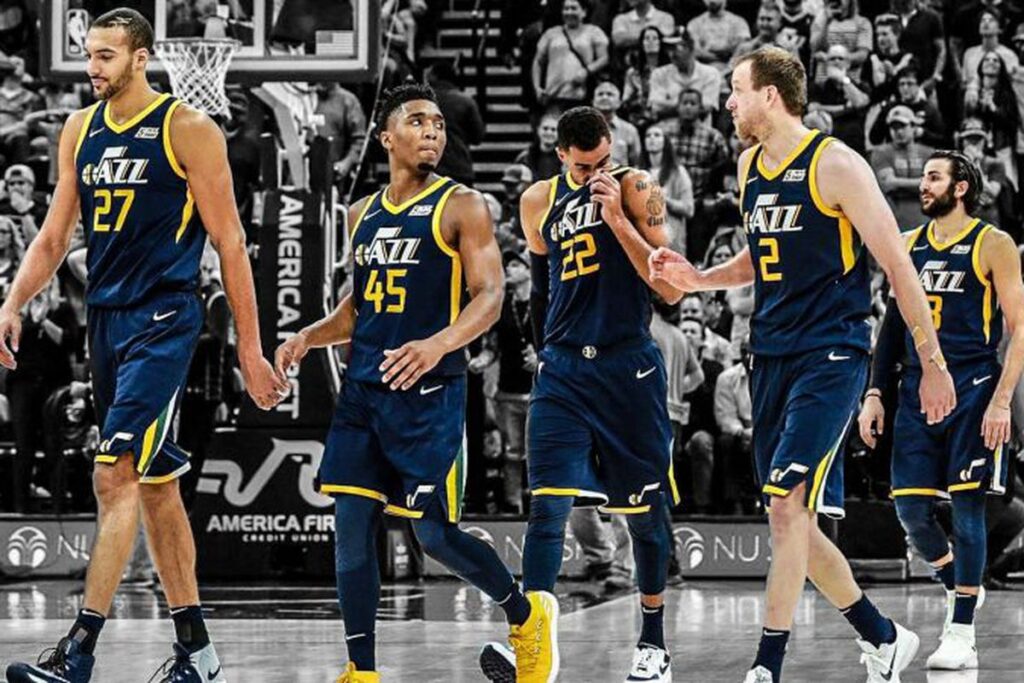Team History
The Utah Jazz’s evolution is a testament to adaptability and perseverance within the dynamic landscape of the NBA. Founded in 1974 as the New Orleans Jazz, the franchise was a nod to the city’s rich musical heritage. However, due to financial difficulties and venue issues, the Jazz relocated to Utah in 1979, a move that initially seemed at odds with the cultural and geographical setting of their new home. Despite retaining their original name, the Utah Jazz would go on to forge a new identity, one that resonates with the spirit and tenacity of their adopted state.
The early years in Utah were marked by a period of adjustment and gradual improvement. The Jazz’s relocation brought about challenges in building a fan base and achieving on-court success. However, the drafting of future NBA legends John Stockton and Karl Malone in the mid-1980s set the stage for the franchise’s rise to prominence. Their synergy on the court, particularly through the pick-and-roll, became a defining feature of the Jazz’s play style and led to significant achievements, including multiple playoff appearances.
As the team transitioned into the 1990s, the Utah Jazz emerged as a powerhouse in the Western Conference, propelled by the leadership of coach Jerry Sloan. The Jazz’s consistency and competitive spirit culminated in back-to-back NBA Finals appearances in 1997 and 1998. Despite falling short of securing a championship, these years represented the peak of Utah Jazz basketball, highlighting the franchise’s growth from its humble beginnings to becoming a mainstay in the NBA playoffs.
Foundation and Early Years
The foundation of the Utah Jazz is a story of ambition, cultural homage, and eventual relocation. Originally established in New Orleans, the team’s name was a tribute to the city’s vibrant jazz music scene. The Jazz’s early years were characterized by struggles on the court and financial instability off it, culminating in the decision to move the franchise to Utah. This move was met with skepticism, given the stark contrast between New Orleans’ musical heritage and Utah’s cultural landscape.
In Utah, the Jazz faced the daunting task of rebuilding their identity and fan base. The acquisition of Pete Maravich, a scoring phenom from the Atlanta Hawks, was a significant milestone in the team’s early efforts to establish credibility and excitement around the franchise. Maravich’s dynamic play and scoring ability provided a foundation for the team to build upon, even as they navigated the challenges of their new environment.
The transition period was marked by gradual improvement, laying the groundwork for future success. The Jazz’s move to Utah eventually proved to be a pivotal moment in the franchise’s history, setting the stage for the drafting of Stockton and Malone, and the establishment of a team culture focused on hard work, community engagement, and competitive spirit. This ethos would define the Utah Jazz for decades to come, transforming them from a struggling expansion team into a respected NBA franchise.
Notable Early Achievements
The Utah Jazz’s path to prominence was paved with notable early achievements that set the foundation for future success. The drafting of John Stockton in 1984 and Karl Malone in 1985 marked the beginning of a new era for the Jazz. Together, Stockton and Malone developed into one of the most iconic duos in NBA history, known for their impeccable pick-and-roll execution. Their chemistry on the court was instrumental in transforming the Jazz into a perennial playoff contender throughout the late 1980s and 1990s.
Under the guidance of coach Jerry Sloan, who took the helm in 1988, the Jazz refined their gritty, disciplined approach to the game, earning respect and admiration across the league. Sloan’s coaching philosophy, centered on teamwork, defense, and a relentless work ethic, became synonymous with Jazz basketball. This period saw the Jazz consistently advance deep into the playoffs, setting the stage for their eventual Western Conference dominance.
The culmination of these efforts was realized in the mid to late 1990s when the Utah Jazz reached the NBA Finals in 1997 and 1998. Despite falling to the Chicago Bulls on both occasions, these appearances were significant milestones for the franchise, highlighting their transition from a struggling team to a dominant force in the NBA. The era of Stockton and Malone, under Sloan’s stewardship, remains a golden period in Jazz history, celebrating the achievements and resilience of a team that consistently defied expectations.
Periods of Change
Following the departure of the legendary duo of Stockton and Malone, the Utah Jazz entered a period of transition and rebuilding. The early 2000s marked a shift in the team’s identity and strategy as they sought to navigate the post-Stockton and Malone era. This period was characterized by the emergence of new talents and the challenge of maintaining the franchise’s competitive edge in a rapidly evolving NBA landscape.
The Jazz’s ability to adapt and rebuild was evident through strategic draft picks and trades, leading to the rise of new stars such as Deron Williams. Under the guidance of coach Jerry Sloan, Williams helped lead the team backto prominence in the playoffs, marking a period of competitive success. This ability to regroup and push forward demonstrated the Jazz’s resilience, a hallmark of the franchise’s approach to team building and management.
The transition continued into the late 2010s, as the Jazz again found themselves in a phase of reconstruction following the departures of key players like Williams. The emergence of Rudy Gobert and Donovan Mitchell signified another era of hope and competitive play for the Jazz. These players brought a renewed energy and dynamic presence on the court, helping the team to secure top seeds in the Western Conference and reigniting the passion of the fan base.
However, the trade of Gobert and Mitchell in 2022 marked the beginning of the latest rebuild, emphasizing youth and potential for future success. This period of change underscores the cyclical nature of professional sports, where teams must continuously adapt and evolve to remain competitive. The Utah Jazz’s history of navigating these transitions with strategic foresight speaks to the resilience and enduring legacy of the franchise.
Championships and Achievements
Despite the absence of an NBA championship title, the Utah Jazz’s history is rich with achievements and milestones that underscore their significance in the league. The Jazz’s back-to-back Western Conference titles in 1997 and 1998 represent the pinnacle of the franchise’s success, showcasing their competitiveness on the league’s biggest stage. These achievements were the result of years of building a cohesive team ethos, underscored by the legendary performances of Stockton and Malone.
The Jazz have also celebrated division titles across various seasons, highlighting their consistent performance and dominance in the regular season. The retirement of jersey numbers of Jazz legends like Stockton, Malone, and others pays homage to the individual contributions that have shaped the franchise’s legacy. These honors reflect the deep respect and admiration the organization holds for those who have contributed significantly to its history.
The resilience of the Jazz is further exemplified by their ability to remain competitive across different eras, adapting to the evolving landscape of the NBA. Whether it’s the enduring legacy of past legends or the potential of new stars, the Utah Jazz continue to be a testament to teamwork, perseverance, and the pursuit of excellence in the realm of professional basketball.
Current Roster
The Utah Jazz’s current roster reflects a blend of seasoned veterans and emerging talent, symbolizing the team’s ongoing commitment to competitiveness and growth. With the franchise in a phase of rebuilding, the focus has shifted towards developing young players and identifying core talents around which to build the future of the team. This strategic approach aims to balance immediate competitiveness with long-term development, ensuring the Jazz remain a formidable presence in the NBA.
Management and coaching staff, under the leadership of general manager Justin Zanik and head coach Will Hardy, are tasked with sculpting this blend of experience and potential into a cohesive unit. Their vision for the team’s future, grounded in the Jazz’s rich tradition of hard work and team-first basketball, is critical to navigating the challenges of the NBA landscape.
As the Jazz look forward, the roster’s evolution will be a key factor in determining the team’s trajectory. The development of young talent, complemented by the guidance of experienced players and a strategic approach from the management and coaching staff, sets the stage for the next chapter in the Utah Jazz’s storied history.
Management and Coaching Staff
The strategic direction and operational excellence of the Utah Jazz are steered by a skilled management and coaching team. General Manager Justin Zanik and Head Coach Will Hardy embody the franchise’s commitment to excellence, innovation, and competitive success. Their leadership roles are pivotal in shaping the team’s strategy, from player acquisitions and development to game-day tactics and long-term planning.
The synergy between the front office and the coaching staff is critical in cultivating a winning culture within the organization. This collaboration ensures that the team’s values and objectives are aligned, from the executive level to the locker room. The management’s focus on fostering a supportive and competitive environment enables the coaching staff to maximize player potential and team performance.
As the Utah Jazz navigate the complexities of the NBA, the roles of Zanik and Hardy, supported by their teams, are instrumental in guiding the franchise towards its goals. Their leadership, vision, and dedication to the Jazz’s ethos of hard work, team spirit, and community engagement are key drivers of the team’s aspirations for success in the league.
Home Stadium Information
The Delta Center, known for its electrifying atmosphere and passionate fan base, serves as the home of the Utah Jazz. Since its opening, the arena has been a fortress for the team, hosting countless memorable games and events that have contributed to the franchise’s rich history. Its location in Salt Lake City, Utah, provides a unique backdrop for the Jazz, offering fans a distinctive and engaging game-day experience.
The stadium’s design and facilities reflect the franchise’s commitment to providing an exceptional environment for players and fans alike. From state-of-the-art amenities to fan engagement initiatives, the Delta Center is more than just a basketball venue; it’s a communityhub for the Jazz, fostering a sense of belonging and pride among its supporters. The home court advantage offered by the Delta Center’s lively atmosphere has been a crucial factor in the Jazz’s performance, particularly during pivotal games and playoff runs.
Moreover, the Delta Center’s role in the community extends beyond just hosting basketball games. It serves as a venue for various events, including concerts, conventions, and other sports activities, making it a central figure in Salt Lake City’s cultural and entertainment landscape. This multifunctionality enhances the bond between the team and its community, reinforcing the Jazz’s presence as a key player in Utah’s social and economic fabric.
The ongoing upgrades and enhancements to the stadium ensure that it remains a top-tier facility, reflecting the Utah Jazz’s commitment to excellence both on and off the court. By investing in the latest technology and fan experiences, the franchise demonstrates its dedication to maintaining a world-class environment for basketball fans. The Delta Center not only symbolizes the Utah Jazz’s rich history and ambitions but also stands as a beacon of community engagement and sporting excellence in Utah.
-
*********** ***** ******* *** ***** ** ************ **** ********* *****dd.mm.yyyy 00:00 PM
-
****** *********** **** ** ***** ****** *** **** *** ******: ********* *** ******* *** ****'* ****dd.mm.yyyy 00:00 PM
-
*********-***** ********: **** 6 **** *** ***** *** * ********* **** 7dd.mm.yyyy 00:00 PM
-
**********-************ *******: ****** ****ć, ******* *******, *** * ********* ********** ********dd.mm.yyyy 00:00 PM
-
********* **** ********* ** *** ***: ********* *** ********* ** ****** ******** **. *** *** *****dd.mm.yyyy 00:00 PM
-
****************** ******* **********: *** ********' **** ****dd.mm.yyyy 00:00 PM







